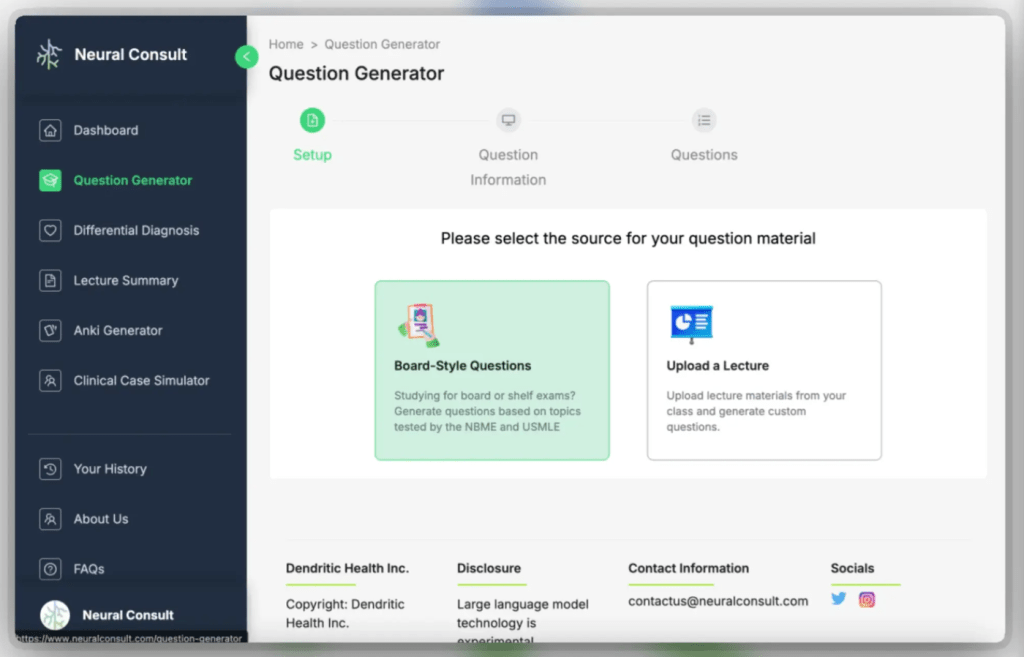
Collaborative learning has become a powerful method in modern medical education, especially when students are preparing for intense board exams. Group study sessions allow peers to challenge each other’s understanding, clarify misconceptions, and learn through active discussion. However, structuring these sessions effectively can be challenging, especially when students have different strengths, weaknesses, and study goals. This is where AI-driven tools, like the Question Generator from Neural Consult, can transform group prep into a productive, data-driven learning experience.
Traditional study groups often fall into disorganized patterns, relying on question banks that may not match everyone’s curriculum or level of understanding. AI tools offer a more customized approach by allowing groups to generate questions from shared lecture materials or uploaded notes. This ensures relevance to their current coursework, and makes discussions more meaningful and efficient. Unlike static question banks, these generators evolve with the group’s needs.
More importantly, peer learning thrives on variety and interaction. The Question Generator makes it easy to create multiple question formats, from recall to clinical reasoning, which allows groups to cover more ground in a single session. With the ability to quickly spin up new content, sessions stay fresh and engaging. Combining this tool with others, like Flashcard Hub and Study Sessions, turns any study group into a mini-academic team.
As competency-based education becomes more prevalent, tools like Neural Consult’s Question Generator align with the trend of personalized learning. According to the Association of American Medical Colleges, peer-based active learning combined with adaptive technology leads to better retention and engagement. In the following sections, we’ll explore five specific ways students can optimize their group sessions using this AI-powered feature.
Use Shared Lecture Uploads to Generate Custom Group Questions

Rather than rely on generic board-style questions, your group can upload your class’s specific lecture slides or summaries into the Question Generator. This ensures the questions you discuss are directly tied to what was taught in class that week. By working through these questions together, students reinforce what’s most likely to appear on in-class quizzes or exams. This approach also mirrors the customization seen in platforms like Firecracker and Quizlet but with a deeper AI-driven contextualization.
Rotate Roles: Student as Instructor
Each group member can take turns using the Question Generator to create a short quiz set for the group. Acting as the instructor encourages ownership of the material and deeper critical thinking. This peer-teaching method is supported by educational research in Active Learning in Higher Education, which shows that teaching peers helps reinforce one’s own understanding. You can take it further by generating explainers from incorrect answers using AI Notebook.
Build Confidence With Rapid-Fire Question Rounds
AI-generated questions can be sorted by topic and difficulty. This lets your group create flash-rounds where members quickly answer one question after another, reinforcing quick recall and boosting test-day confidence. It’s a fun and competitive way to review large volumes of material. And by integrating with Flashcard Hub, you can convert trickier questions into spaced-repetition cards for individual follow-up.
Tag and Track Missed Topics With Study Sessions
After your group has worked through a batch of generated questions, log which topics gave your team trouble. You can tag those subjects inside Neural Consult and launch a targeted Study Session later in the week to reinforce weak points. This cycle of question > discussion > remediation mirrors competency-based feedback loops used in clinical education environments and suggested by MedEdPORTAL.
Combine With OSCE Simulation for Integrated Learning
For groups preparing for clinical years or Objective Structured Clinical Examinations, you can use questions as warm-ups before launching a case simulation. For instance, a set of cardiology multiple-choice questions can lead into a patient simulation on chest pain. This integration between question generation and hands-on learning mimics real-world medical decision-making and is supported by findings from the British Medical Journal.
Conclusion
Using AI-generated questions in a group setting fosters collaboration while ensuring the content stays aligned with your curriculum. Group sessions become more efficient when everyone works off the same set of personalized questions, derived directly from shared lectures and current topics. This approach not only makes learning more interactive but also reinforces recall, reasoning, and teaching skills within the group.